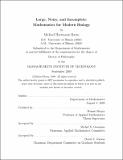| dc.contributor.advisor | Bonnie Berger. | en_US |
| dc.contributor.author | Baym, Michael Hartmann | en_US |
| dc.contributor.other | Massachusetts Institute of Technology. Dept. of Mathematics. | en_US |
| dc.date.accessioned | 2010-04-26T19:41:23Z | |
| dc.date.available | 2010-04-26T19:41:23Z | |
| dc.date.copyright | 2009 | en_US |
| dc.date.issued | 2009 | en_US |
| dc.identifier.uri | http://hdl.handle.net/1721.1/54234 | |
| dc.description | Thesis (Ph. D.)--Massachusetts Institute of Technology, Dept. of Mathematics, 2009. | en_US |
| dc.description | This electronic version was submitted by the student author. The certified thesis is available in the Institute Archives and Special Collections. | en_US |
| dc.description | Cataloged from student-submitted PDF version of thesis. | en_US |
| dc.description | Includes bibliographical references (p. 115-124). | en_US |
| dc.description.abstract | In recent years there has been a great deal of new activity at the interface of biology and computation. This has largely been driven by the massive in flux of data from new experimental technologies, particularly high-throughput sequencing and array-based data. These new data sources require both computational power and new mathematics to properly piece them apart. This thesis discusses two problems in this field, network reconstruction and multiple network alignment, and draws the beginnings of a connection between information theory and population genetics. The first section addresses cellular signaling network inference. A central challenge in systems biology is the reconstruction of biological networks from high-throughput data sets, We introduce a new method based on parameterized modeling to infer signaling networks from perturbation data. We use this on Microarray data from RNAi knockout experiments to reconstruct the Rho signaling network in Drosophila. The second section addresses information theory and population genetics. While much has been proven about population genetics, a connection with information theory has never been drawn. We show that genetic drift is naturally measured in terms of the entropy of the allele distribution. We further sketch a structural connection between the two fields. The final section addresses multiple network alignment. With the increasing availability of large protein-protein interaction networks, the question of protein network alignment is becoming central to systems biology. | en_US |
| dc.description.abstract | (cont.) We introduce a new algorithm, IsoRankN to compute a global alignment of multiple protein networks. We test this on the five known eukaryotic protein-protein interaction (PPI) networks and show that it outperforms existing techniques. | en_US |
| dc.description.statementofresponsibility | by Michael Hartmann Baym. | en_US |
| dc.format.extent | 124 p. | en_US |
| dc.language.iso | eng | en_US |
| dc.publisher | Massachusetts Institute of Technology | en_US |
| dc.rights | M.I.T. theses are protected by
copyright. They may be viewed from this source for any purpose, but
reproduction or distribution in any format is prohibited without written
permission. See provided URL for inquiries about permission. | en_US |
| dc.rights.uri | http://dspace.mit.edu/handle/1721.1/7582 | en_US |
| dc.subject | Mathematics. | en_US |
| dc.title | Large, noisy, and incomplete : mathematics for modern biology | en_US |
| dc.title.alternative | Mathematics for modern biology | en_US |
| dc.type | Thesis | en_US |
| dc.description.degree | Ph.D. | en_US |
| dc.contributor.department | Massachusetts Institute of Technology. Department of Mathematics | |
| dc.identifier.oclc | 606916172 | en_US |

